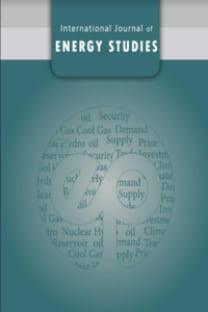Decontamination applications in primary circuit equipment of nuclear power plants
Decontamination applications in primary circuit equipment of nuclear power plants
Decontamination, Nuclear Power Plants Radioactivity, contamination,
___
- [1] International Atomic Energy Agency. Safety Series No.48: Manual on Decontamination Surfaces. IAEA Publishing Section, Vienna, Austria, 1979.
- [2] Japan Atomic Energy Agency. Environmental Contamination and Decontamination in the Fukushima Accident. Nuclear Human Resource Development Center, Tokyo, Japan, 2016.
- [3] Liu S, He Y, Xie H, Ge Y, Lin Y, Yao Z, Jin M, Liu J, Chen X, Sun Y, Wang B. A State-of-the-Art Review of Radioactive Decontamination Technologies: Facing the Upcoming Wave of Decommissioning and Dismantling of Nuclear Facilities. Sustainability 2022; 14(7): 4021. https://doi.org/10.3390/su14074021.
- [4] Boing L. Decontamination Technologies. IAEA Decommissioning of Nuclear Facilities Congress, Manila, Philippines, 2006.
- [5] European Commission Co-ordination Network on Decommissioning of Nuclear Installations. Dismantling Techniques, Decontamination Techniques, Dissemination of Best Practice, Experience and Know-how. Office for Official Publications in EU, Luxembourg, 2009.
- [6] Lesage LG, Sarkisov AA. Nuclear Submarine Decommissioning and Related Problems. Kluwar Academic Publisher, London, UK, 1995.
- [7] Ponnet M, Klein M, Rahier A. Chemical Decontamination Medoc Using Cerium IV and Ozone. WM'00 Conference, Brussel, Belgium, 2000.
- [8] Wille H, Bertholdt HO, Roumiguiere F. Chemical Decontamination with the CORD UV Process: Principle and Field Experience. Nuclear Energy in Central Europe, Bled, Slovenia, 1997.
- [9] Archibald K, Demmer R, Argyle M, Ancho M, Hai-Pao J. NPOX Decontamination System. WM’02 Symposia Proceed International Conference, Tucson, US, 2002.
- [10] Nuclear Energy Agency. Decontamination Techniques Used in Decommisioning Activities. Organisation for Economic Co-operation and Development, Paris, France, 1998.
- [11] Hebrant P. Lending piping a new lease of life. Nuclear Engineering International 1989; 34 (414); 48-49.
- [12] Westinghouse Idaho Nuclear Company. Testing and Evaluation of Eight Decontamination Chemicals. WINCO-1228, Idaho, US, 1994.
- [13] Kim SW, Park SY, Roh CH, Shim JH, Kim SB. Electrochemical corrosion study on base metals used in nuclear power plants in the Hybrid process for chemical decontamination. Nuclear Engineering and Technology 2022; 54: 2329-2333. https://doi.org/10.1016/j.net.2021.12.008.
- [14] Qiang W, Chuan W. Study on Application of Joint Ultrasound - Chemical Decontamination Technology in Nuclear Power Plants. Applied Chemical Industry 2007; 36: 90-95.
- [15] Shin JM, Kim KH, Park JJ, Lee HH, Yang MS, Nam SH, Kim MJ. A state of the art report on the decontamination technology for dry ice blasting. KAERI Inst, Seul, South Korea, 2000.
- [16] Zhao P, Chung W, Lee M, Ahn S. Experimental Study on Melt Decontamination of Stainless Steel and Carbon Steel Using Induction Melting. Metals 2021; 11(8):1218. https://doi.org/10.3390/met11081218.
- [17] Nedyalkova IP. Decontamination of Nuclear Plant Steels. PhD Thesis, University of Manchester, 2018.
- [18] Zhong L, Lei J, Deng J, Lei Z, Lei L, Xu X. Existing and potential decontamination methods for radioactively contaminated metals-A Review. Progress in Nuclear Energy 2021; 139: 103854. https://doi.org/10.1016/j.pnucene.2021.103854.
- [19] Federal Authority for Nuclear Regulation. Regulation for Radiation Dose Limits and Optimisation of Radiation Protection for Nuclear Facilities. Official Bulletin, Abu Dhabi, United Arab Emirates, 2010.
- [20] Canadian Nuclear Safety Commission. Radiation Protection Regulation. Official Bulletin, Ottawa, Canada, 2017.
- [21] Choi KW, Kim BI. Regulatory Consideration On Decommissioning Facilitation Of Nuclear Power. American Nuclear Society, San Francisco, US, 2017.
- [22] International Atomic Energy Agency. Safety Guide WSG-2.1,Decommissioning of Nuclear Power Plants and Research Reactors. IAEA Publishing Section, Vienna, Austria, 1999.
- [23] Munson LF, Divine JR, Martin JB. Planning Guidance for Nuclear Power Plant Decontamination. NRC Publishing, Washington US, 1983.
- [24] Nuclear Regulatory Authority. Outline of Nuclear Regulation of Japan. NRA, Tokyo, Japan, 2015.
- [25] Finland Nuclear and Radiation Safety Authority. Reactor coolant circuit of a nuclear power plant guide YVLB-5. STUK publishing section, Helsinki, Finland, 2013.
- [26] Choi BS, Choi WK, Banerjee A, Kim SB, Seo BK. Technical requirements of the chemical decontamination for the PHWRs system. Transactions of the Korean Nuclear Society Virtual Spring Meeting, Seul, Republic of Korea, 2020.
- [27] Türkiye Atom Enerjisi Kurumu. Radyoaktif Atık Yönetimi Yönetmeliği. Official Bulletin of Turkey, Ankara, Türkiye, 2013.
- [28] Türkiye Atom Enerjisi Kurumu. Nükleer Tesislerde Serbestleştirme ve Sahanın Düzenleyici Kontrolden Çıkarılmasına İlişkin Yönetmelik. Official Bulletin of Turkey, Ankara, Türkiye, 2013.
- [29] Enerji ve Tabii Kaynaklar Bakanlığı. Radyoaktif Maddenin Güvenli Taşınması Yönetmeliği. Official Bulletin of Turkey, Ankara, Türkiye, 2005.
- [30] Türkiye Atom Enerjisi Kurumu. Radyasyon Güvenliği Yönetmeliği. Official Bulletin of Turkey, Ankara, Türkiye, 2000.
- [31] Türkiye Atom Enerjisi Kurumu.Kontrollü Alanlarda Çalışan Harici Görevlilerin İyonlaştırıcı Radyasyondan Kaynaklanabilecek Risklere Karşı Korunmasına Dair Yönetmelik. Official Bulletin of Turkey, Ankara, Türkiye, 2011.
- Yayın Aralığı: Yılda 4 Sayı
- Başlangıç: 2016
- Yayıncı: Türkiye Enerji Stratejileri ve Politikaları Araştırma Merkezi (TESPAM)
Berk SÜRÜCÜ, Murat ÖZTÜRK, Erdem ÇİFTÇİ, Azim Doğuş TUNCER
Production and determination of properties of ethanol from mango and orange peels
Anas BALA, Richard Balthi MSHELİA, Jamilu Ya'u MUHAMMAD, M ADAM
The challenges and serviceability of solar power: suggestion on solving the Nigeria energy crisis
Ayşe TANSU, Ayomide Titus OGUNGBEMİ, Fatma TANSU HOCANIN
Decontamination applications in primary circuit equipment of nuclear power plants
